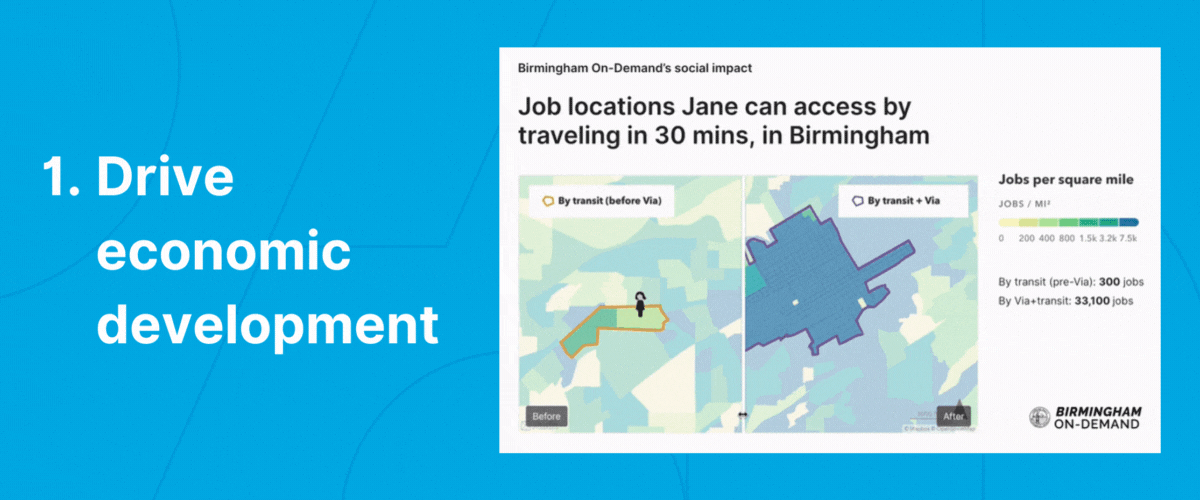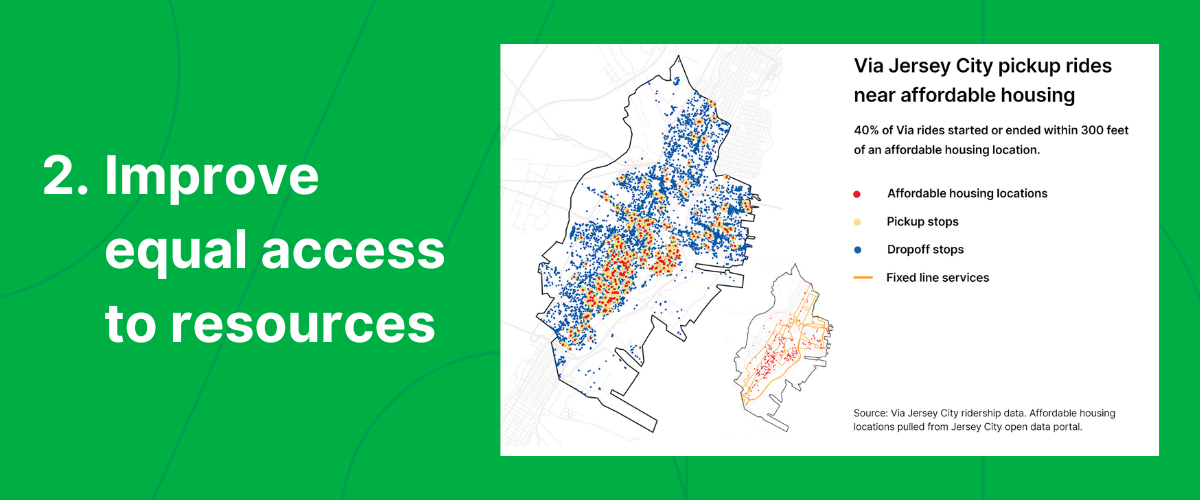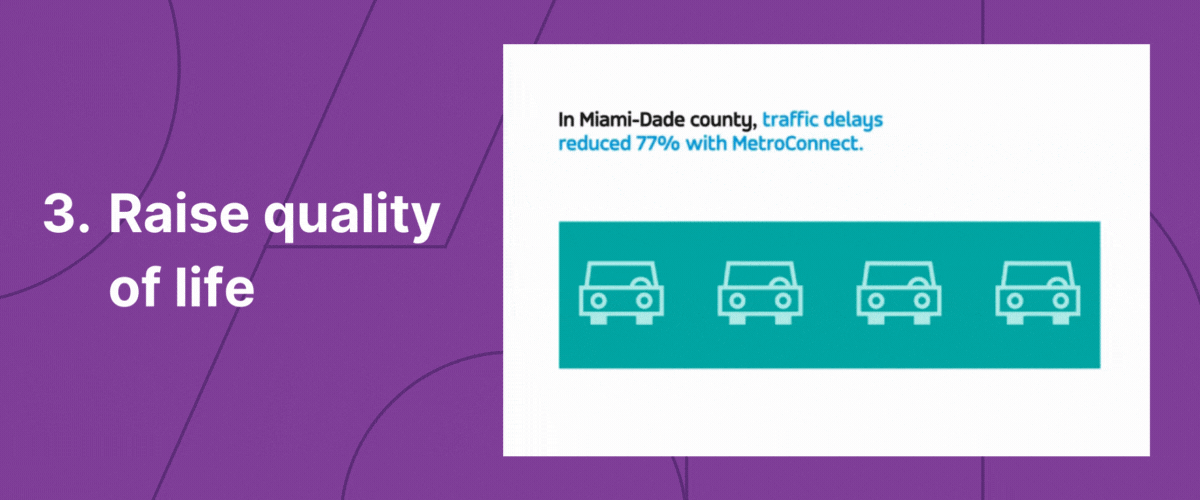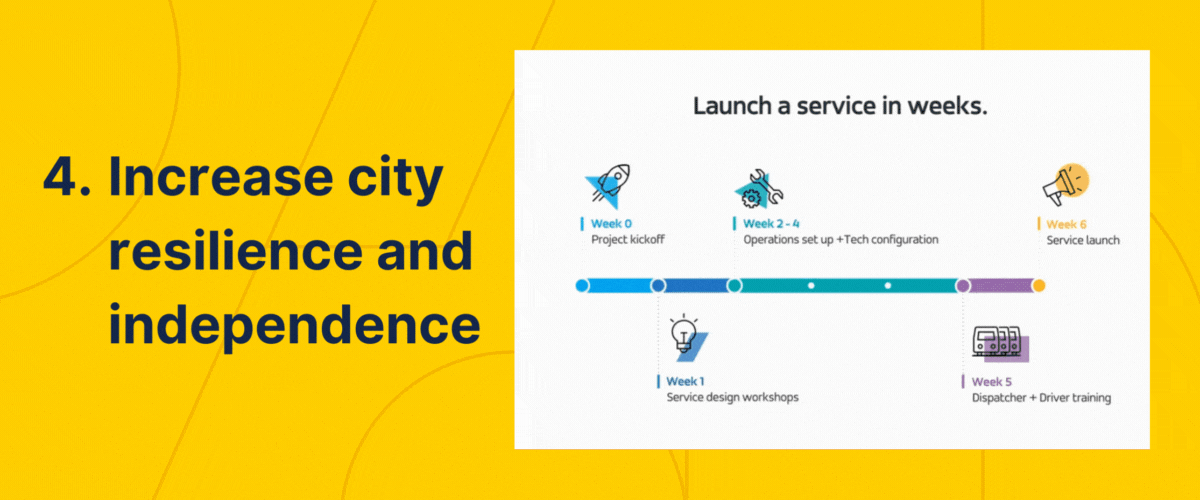We’ve worked with a lot of city governments, and we’ve seen it firsthand: mayors, council members, and city managers are always juggling competing priorities with limited time and budget. Luckily, better transit is something that can help improve nearly every aspect of city life, from economic development to social equity to traffic congestion.
On-demand microtransit is a service that’s easy to launch, and even easier to adjust in response to changing priorities down the road. Learn how other Via partners are already doing it.
- Drive economic development
- Improve equal access to resources
- Raise quality of life
- Increase city resilience and independence

You may have heard that every $1 of investment in transit leads to $5 in returns — it’s a commonly-cited stat from the American Public Transportation Association (APTA). But what’s actually driving this phenomenon? What changes in your city as a result of better transit, and how does that drive economic growth?
At Via, our data points to three major factors:
- Improving access to jobs. Better transit means that people can access more jobs — and that employers can draw employees from a wider area. Via’s U.S. microtransit services increased access to jobs by 40% on average.
- Lowering commute times. A long commute is a significant hindrance to economic mobility — and Via-powered microtransit services keep commute times in check. In some Via-powered cities, 40% of riders routinely report “reduced commute time” as a chief benefit to the service, only outranked by “saving money.”
- Enabling more productive land use. As cities across the country abandon parking minimums, flexible, low-infrastructure transit solutions like microtransit play a key role moving people to and around more densely-developed downtowns. Our service in Memphis, Groove On-Demand, was designed in collaboration with an economic development organization (the Downtown Memphis Commission) specifically to avoid building new parking structures downtown and facilitate economic growth.

In many US cities, car ownership is a prerequisite to access basic necessities like affordable housing, groceries, healthcare, and education. For citizens who don’t drive — because they can’t afford a car, or can’t drive one due to age or disability — a viable mobility alternative is critical to fostering equity.
In Via-powered cities across the country, microtransit is helping mayors create more equitable cities by:
- Improving access to healthcare and education. Across the U.S., Via services enable access to 70% more hospitals and 66% more schools than would be reachable by fixed-route transit alone.
- Linking affordable housing to opportunities. A broader transit network brings more affordable housing within reasonable travel times, easing stress on centrally-located housing stock. In Jersey City, we found that 40% of Via microtransit rides started or ended at an affordable housing location.
- Offering a new option for independence for seniors and people with disabilities. Ineffective public transit disproportionately affects people who can’t drive a car: of the Via riders who would not have been able to travel without microtransit, 87% report that they don’t own a car and 26% report having a long-term disability.

Private cars are not only an unequal resource, but an inconvenience even for those who can afford them — and the cities where they live. They are increasingly expensive to own, and contribute dramatically to traffic congestion and environmental pollution along the most well-traveled corridors.
Microtransit can raise quality of life for city residents in a few ways:
- Saving money on vehicle ownership. The cost of car ownership has skyrocketed in recent years, becoming easily the second-highest household expense after rent or mortgage payments. We don’t envision that every household will go completely car-free as a result of better transit — but we do see that microtransit helps people use single-occupancy vehicles less frequently, with 37% of Via passengers reporting they would have otherwise traveled in one.
- Reducing traffic congestion. Another benefit of getting those 37% of passengers out of private vehicles? An easier time on the road for those who still need to drive. In Miami-Dade County, the MetroConnect microtransit service is estimated to have contributed to 77% fewer hours spent in traffic when compared against how riders would have otherwise traveled.

Perhaps most importantly, tech-enabled microtransit is a transit mode that any city government can implement, with minimal time, resources, and expertise. Our city partners set the goals, budget, and performance expectations — and Via can help with the detailed service plan, funding strategy, and after launch, the day-to-day management of drivers and vehicles.
What does this approach bring to your city?
- A transit program that complements and supplements what your local transit agency brings to the table. When New Jersey Transit cut bus routes in Jersey City, Mayor Fulop responded by launching one of the country’s most successful microtransit services. Microtransit lets Jersey City fill gaps in their fixed-route network in a way that ultimately strengthens bus and rail ridership: features of both the service design and the algorithm encourage travel to and from transit hubs, and make it impossible for riders to request microtransit trips that could be effectively served by fixed-route options.
- A nimble, bureaucracy-light transit system that stays aligned with your goals — even as they change. Microtransit requires little in the way of traditional transit infrastructure, and services can launch quickly and change on a dime in response to evolving city needs or performance statistics. Where transit agencies often require layers upon layers of approvals for small service changes, Via-powered microtransit grows with your city in real time. If a new employer sets up a warehouse just outside your service zone, a service expansion can be scoped and implemented in a matter of hours.
Curious to learn more? Reach out!

Via Resource Editor




%206.png?width=71&height=47&name=The%20Buzz%20Blog%20Hero%20(1750%20x%201200%20px)%206.png)